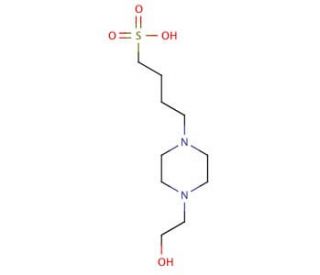

HEPBS (CAS 161308-36-7)
See product citations (2)
QUICK LINKS
HEPBS, or 2-(Hydroxyethyl)piperazine-N′-2′-ethanesulfonic acid, is a zwitterionic biological buffer used extensively in biochemical and molecular biology research to maintain pH stability within physiological ranges. Its unique structure incorporates both a piperazine ring and an ethanesulfonic acid moiety, which contribute to its buffering capacity and solubility. HEPBS is particularly valued for its minimal metal ion binding, which is crucial in experiments sensitive to metal chelation effects. Unlike many traditional buffers, HEPBS operates effectively at near-physiological pH, typically between 6.8 and 8.2, making it ideal for maintaining the environment required for enzyme reactions and cellular cultures without perturbing the natural ionic balance. Its mechanism of action lies in its ability to release or absorb protons in response to changes in the pH of the solution, thereby stabilizing the pH by preventing drastic shifts. HEPBS has been instrumental in research environments, particularly in studies involving protein-ligand interactions, where maintaining a consistent pH is essential to avoid altering the structure and function of the proteins under study. Additionally, it has been used in the preparation of media for biological assays and as a buffering agent in electrophoresis and other biochemical analytical methods, showcasing its versatility and critical role in scientific investigations.
HEPBS (CAS 161308-36-7) References
- Buffers for the physiological pH range: acidic dissociation constants of zwitterionic compounds in various hydroorganic media. | Taha, M. 2005. Ann Chim. 95: 105-9. PMID: 15801182
- High-sensitivity microchip electrophoresis determination of inorganic anions and oxalate in atmospheric aerosols with adjustable selectivity and conductivity detection. | Noblitt, SD., et al. 2009. J Chromatogr A. 1216: 1503-10. PMID: 19162269
- Reactions of buffers in cyanogen bromide-induced ligations. | Vogel, H., et al. 2013. Nucleosides Nucleotides Nucleic Acids. 32: 17-27. PMID: 23360292
- Single-Molecule Observation of Intermediates in Bioorthogonal 2-Cyanobenzothiazole Chemistry. | Qing, Y., et al. 2020. Angew Chem Int Ed Engl. 59: 15711-15716. PMID: 32589803
- Intrinsic Apyrase-Like Activity of Cerium-Based Metal-Organic Frameworks (MOFs): Dephosphorylation of Adenosine Tri- and Diphosphate. | Yang, J., et al. 2020. Angew Chem Int Ed Engl. 59: 22952-22956. PMID: 32902900
- High Fidelity Enzyme-Free Primer Extension with an Ethynylpyridone Thymidine Analog. | Han, J., et al. 2021. Chemistry. 27: 15918-15921. PMID: 34559417
- Mobile Molecules: Reactivity Profiling Guides Faster Movement on a Cysteine Track. | Bo, Z., et al. 2023. Angew Chem Int Ed Engl. 62: e202300890. PMID: 36930533
- Evaluation of Hepatitis in Pediatric Patients With Presumed Nonalcoholic Fatty Liver Disease. | Al-Harthy, F., et al. 2022. JPGN Rep. 3: e181. PMID: 37168906
- Human Minor Salivary Glands: A Readily Available Source of Salivary Stem/Progenitor Cells for Regenerative Applications. | Barrows, CML., et al. 2024. Methods Mol Biol. 2749: 25-38. PMID: 38133771
- Mobile Molecules: Reactivity Profiling Guides Faster Movement on a Cysteine Track. | Bo, Z., et al. 2023. Angew Chem Weinheim Bergstr Ger. 135: e202300890. PMID: 38529338
Ordering Information
| Product Name | Catalog # | UNIT | Price | Qty | FAVORITES | |
HEPBS, 25 g | sc-286006 | 25 g | $178.00 | |||
HEPBS, 100 g | sc-286006A | 100 g | $350.00 |
